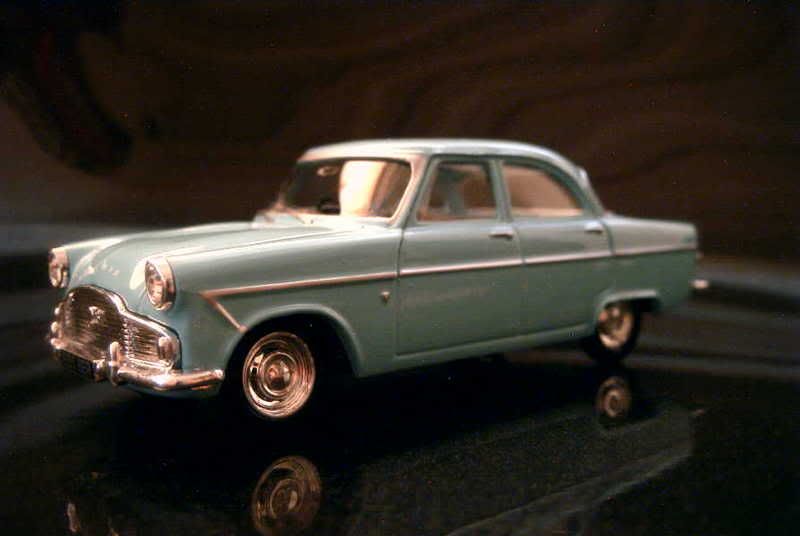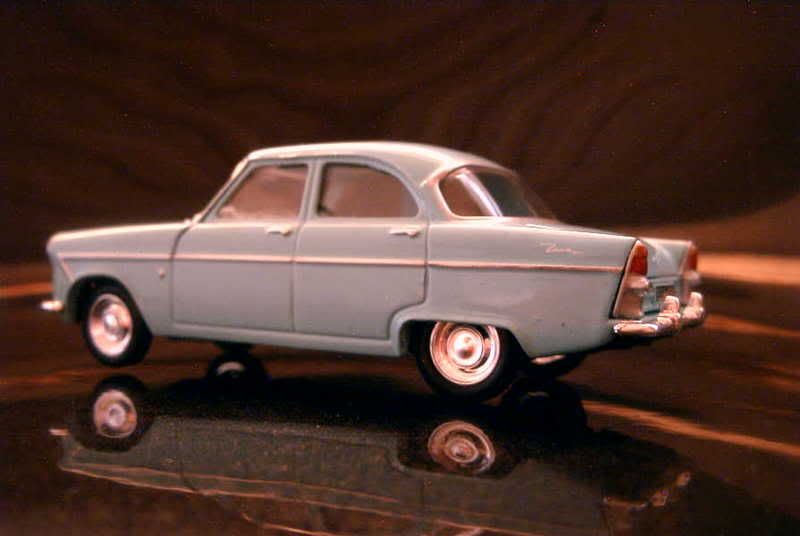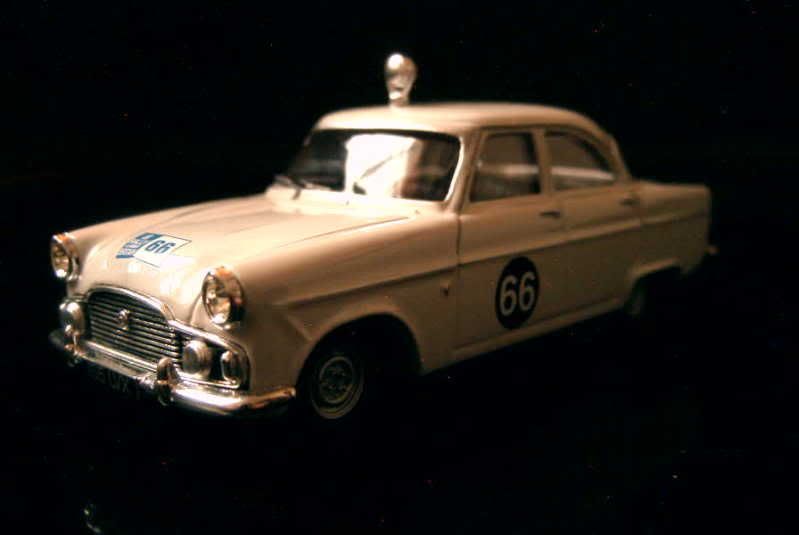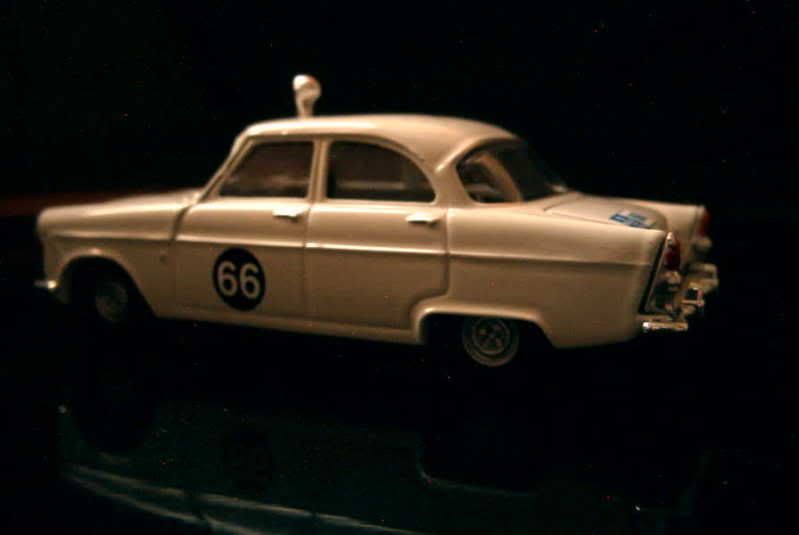A little history
In April 1956, Ford U.K. replaced its whole line-up of large saloons by three new models, which soon earned themselves the nickname The Three Graces. These cars, namely the 4-cylinder Consul, its 6-cylinder counterpart Zephyr and the luxury Zodiac, were indeed beautiful, particularly when opposed to the bathtub-styled first generation of big Fords. The inspiration was definitely American, as for many European cars of the hour, but knew how to remain tasteful, with a relative restraint on chromes, delicate rear fins and optional two-tone paints.
On the mechanical side, these cars remained extremely orthodox. Six-cylinder versions rode on a slightly longer chassis than the Consul. But for all of them, transmission was to the rear wheels through a three-speed manual gearbox, though an automatic Borg-Warner was now optional. Large drum brakes were thought to be sufficient for stopping the cars.
The car had grown bigger, so did its engines. The base motor fitted to the Consul was a 1.7-litre developing 59 bhp, while both the Zephyr and the Zodiac used similar 2.6-litre engines good for 86 bhp. The performances were modest, with top speeds close to 125 and 140 kph respectively for the four and the six, but few bothered back then. Straight from the factory, a Ford customer could choose any body type, as long as it was a four-door saloon. Converted estates (by Abbott) and convertibles (by Carbodies) were available, though. On the Australian market, a pickup or, in the local parlance, a “ute”, was also offered.
An instant hit, the Mark II series didn’t change much throughout its production run. It was nonetheless face-lifted in 1959, when the roof was lowered by almost 4.5 centimetres. Various details were also updated. The following year, front disk brakes became available as an option. In this final incarnation, the Mark II remained available until April 1962, when its style, deeply rooted in the Fifties, gave way to a fresh new design. To this day, it probably remains for the British as the most regretted of all “big Fords”.
About the models
Model: Ford Zephyr Mk.II
Year: 1956
Maker: Vanguards - Corgi
Scale: 1/43
Distributed by: Vanguards
Acquired: brand new, in January 2007, in Hong Kong, S.A.R.
Vanguards did a very nice model of the Zephyr Mk.II. Seeing the miniature is enough to understand why the car had such a success in Britain when it was released. My rating: 13/20.


Model: Ford Zephyr Mk.II
Year: 1959
Event: 1959 RAC Rally, driven by Gerry Burgess, assisted by Sam Croft-Pearson (overall winners)
Maker: Vanguards - Corgi
Scale: 1/43
Distributed by: Vanguards
Acquired: brand new, in December 2006, in Hong Kong, S.A.R.
Using the same casting as the road car, Vanguards decided to produce the model of the (disputed) winner of the '59 RAC Rally. As Fifties Rally racers were extremely close to road cars, the task was probably fairly easy: three new projectors, including one on the roof, wheels without hubcaps, road numbers, that's done! I'd give it the same rate of 13/20.


In April 1956, Ford U.K. replaced its whole line-up of large saloons by three new models, which soon earned themselves the nickname The Three Graces. These cars, namely the 4-cylinder Consul, its 6-cylinder counterpart Zephyr and the luxury Zodiac, were indeed beautiful, particularly when opposed to the bathtub-styled first generation of big Fords. The inspiration was definitely American, as for many European cars of the hour, but knew how to remain tasteful, with a relative restraint on chromes, delicate rear fins and optional two-tone paints.
On the mechanical side, these cars remained extremely orthodox. Six-cylinder versions rode on a slightly longer chassis than the Consul. But for all of them, transmission was to the rear wheels through a three-speed manual gearbox, though an automatic Borg-Warner was now optional. Large drum brakes were thought to be sufficient for stopping the cars.
The car had grown bigger, so did its engines. The base motor fitted to the Consul was a 1.7-litre developing 59 bhp, while both the Zephyr and the Zodiac used similar 2.6-litre engines good for 86 bhp. The performances were modest, with top speeds close to 125 and 140 kph respectively for the four and the six, but few bothered back then. Straight from the factory, a Ford customer could choose any body type, as long as it was a four-door saloon. Converted estates (by Abbott) and convertibles (by Carbodies) were available, though. On the Australian market, a pickup or, in the local parlance, a “ute”, was also offered.
An instant hit, the Mark II series didn’t change much throughout its production run. It was nonetheless face-lifted in 1959, when the roof was lowered by almost 4.5 centimetres. Various details were also updated. The following year, front disk brakes became available as an option. In this final incarnation, the Mark II remained available until April 1962, when its style, deeply rooted in the Fifties, gave way to a fresh new design. To this day, it probably remains for the British as the most regretted of all “big Fords”.
About the models
Model: Ford Zephyr Mk.II
Year: 1956
Maker: Vanguards - Corgi
Scale: 1/43
Distributed by: Vanguards
Acquired: brand new, in January 2007, in Hong Kong, S.A.R.
Vanguards did a very nice model of the Zephyr Mk.II. Seeing the miniature is enough to understand why the car had such a success in Britain when it was released. My rating: 13/20.


Model: Ford Zephyr Mk.II
Year: 1959
Event: 1959 RAC Rally, driven by Gerry Burgess, assisted by Sam Croft-Pearson (overall winners)
Maker: Vanguards - Corgi
Scale: 1/43
Distributed by: Vanguards
Acquired: brand new, in December 2006, in Hong Kong, S.A.R.
Using the same casting as the road car, Vanguards decided to produce the model of the (disputed) winner of the '59 RAC Rally. As Fifties Rally racers were extremely close to road cars, the task was probably fairly easy: three new projectors, including one on the roof, wheels without hubcaps, road numbers, that's done! I'd give it the same rate of 13/20.





No comments:
Post a Comment